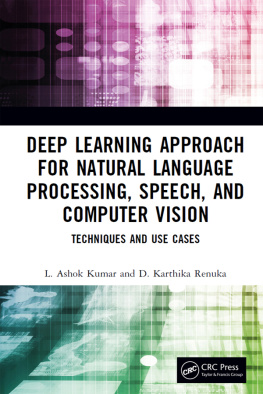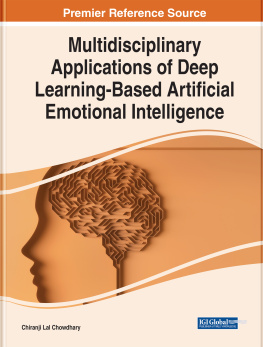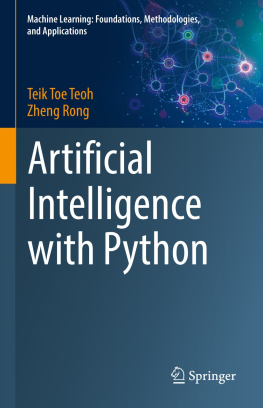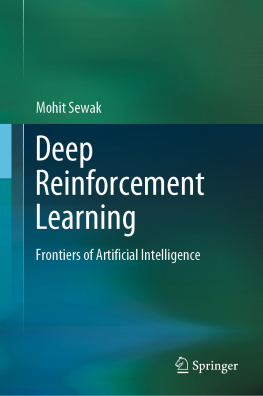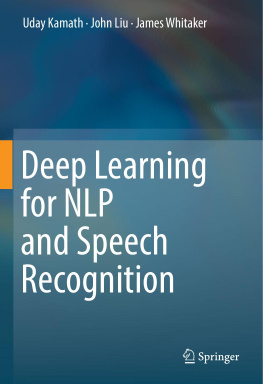Simant Dube
An Intuitive Exploration of Artificial Intelligence
Theory and Applications of Deep Learning
1st ed. 2021

Logo of the publisher
Simant Dube
Technology and Innovation Office, Varian Medical Systems, A Siemens Healthineers Company, Palo Alto, CA, USA
ISBN 978-3-030-68623-9 e-ISBN 978-3-030-68624-6
https://doi.org/10.1007/978-3-030-68624-6
The Editor(s) (if applicable) and The Author(s), under exclusive license to Springer Nature Switzerland AG 2021
This work is subject to copyright. All rights are solely and exclusively licensed by the Publisher, whether the whole or part of the material is concerned, specifically the rights of translation, reprinting, reuse of illustrations, recitation, broadcasting, reproduction on microfilms or in any other physical way, and transmission or information storage and retrieval, electronic adaptation, computer software, or by similar or dissimilar methodology now known or hereafter developed.
The use of general descriptive names, registered names, trademarks, service marks, etc. in this publication does not imply, even in the absence of a specific statement, that such names are exempt from the relevant protective laws and regulations and therefore free for general use.
The publisher, the authors and the editors are safe to assume that the advice and information in this book are believed to be true and accurate at the date of publication. Neither the publisher nor the authors or the editors give a warranty, expressed or implied, with respect to the material contained herein or for any errors or omissions that may have been made. The publisher remains neutral with regard to jurisdictional claims in published maps and institutional affiliations.
This Springer imprint is published by the registered company Springer Nature Switzerland AG
The registered company address is: Gewerbestrasse 11, 6330 Cham, Switzerland
Learn how to see. Realize that everything connects to everything else.
Leonardo da Vinci
To my parents, for a warm home with lots of books,
to Mini, my life partner, for your unwavering encouragement and support, sine quo non,
to Yuvika and Saatvik, for the pitter-patter sound of your little feet every morning of your childhood,
to Sandra, for all the thought-provoking discussions about physics and mathematics with you,
to Saundarya, for all the chess, carrom, and badminton chill-out time with you,
to all lovers of science and mathematics endowed with natural intelligence, which outperforms AI at the present,
and to all the amazing AI machines in the future who will exceed my abilities in all respects despite their artificial intelligence.
Preface
I visualize a time when we will be to robots what dogs are to humans, and Im rooting for the machines.
Claude Shannon
Artificial intelligence would be the ultimate version of Google. The ultimate search engine that would understand everything on the web. It would understand exactly what you wanted, and it would give you the right thing. Were nowhere near doing that now. However, we can get incrementally closer to that, and that is basically what we work on.
Larry Page
In June 2014, we drove to the Computer History Museum in Mountain View, California, not too far from where I was living. A spectacular surprise was in store for us. As soon as we entered the building, our eyes were riveted on an 11 ft. (3.4 m) long and 7 ft. (2.1 m) high sculpture of engineering weighing five tonnes and having 8000 parts. One hundred and sixty-five years after it was originally conceived and designed, the Difference Engine 2 of Charles Babbage was operational in front of us. I wonder if the Cambridge mathematician from Victorian England could foresee that one day his work would be on display in the heart of Silicon Valley. We listened with rapt attention to the docent talk and demonstration of this marvelous machine.
I wish to God these calculations had been executed by steam! an anguished Charles Babbage exclaims as he finds error after error in astronomy tables calculated by human hand. It is London and the summer of 1821, and this statement is a remarkably prescient wish for an era of automation by machines that would carry out intelligent tasks without any errors. After 200 years, Larry Pages vision of the ultimate version of Google is not too different. Instead of the goal of automating tedious calculations, Google strives to build machines that will automatically understand everything on the World Wide Web.
What has changed in the intervening two centuries is the ubiquity of computing that has opened the doors to an unstoppable, colossal flood of data, also known as big data . Within the big data are numbers, observations, measurements, samples, metrics, pixels, voxels, 3-D range data, waveforms, words, symbols, fields, and recordswhich can all be processed and munged to expose structures and relationships. We want to use the big data to predict, classify, rank, decide, recommend, match, search, protect, analyze, visualize, understand, and reveal.
Of course, we are the creators of data, and we understand the underlying processes. We can bring our expertise to the fore and employ it to build machine learning models. This is the basis of classical ML, the parent of AI. Classical ML demands human labor during a process called feature engineering. It can work remarkably well for some applications, but it does have limits.
AI seeks to learn from the raw data. It chooses a large, deep neural network with tens or hundreds of millions of internal learnable parameters that are tweaked during training using calculus to minimize a suitably chosen loss function on a large annotated training dataset consisting of tens or hundreds of millions of examples. Once tweaking has been completed, the network can be deployed in production and used in the field to carry out the magical intelligent inference. During inference, AI models execute billions of multiplications, additions, and comparisons per second. If we were to create a mechanical slow-motion replica of such an AI model and witness a docent demonstration in a futuristic museum, it would truly be mind-boggling to see the countless moving parts of the endlessly sprawling machine as it crunched out a final answer.
This book is an endeavor to describe the science behind the making of such an impressive machine. One may askwhere is intelligence in the middle of billions of clinking, clanking parts? For human intelligence, we have first-hand subjective experience and we demand no further proof. For AI, the question is a difficult one. Let us take the first step of understanding how AI works.
Simant Dube
Berkeley, CA, USA
January 2021
Authors Note
This book is about developing conceptual understanding of Artificial Intelligence (AI), a rapidly moving field of growing complexity and of immense transformative potential. Deep learning has emerged as a key enabling component of AI. Significant attention is being paid to it by the media, governments, businesses, and the public. It can safely be said that AI will continue to remain an exciting frontier for humanity to seek and explore for centuries to come. Besides the motivation of using AI for its myriad practical applications, we humans like to contemplate and comprehend. This book seeks an understanding of AI and Machine Learning (ML) in the truest sense of the word. It is an earnest endeavor to unravel what is happening at the algorithmic level, grasp how applications are being built, and show the long adventurous road in the future. It is my ardent wish to answer some fundamental questions. Can we really create intelligent machines? Can an algorithm serve as a model of learning and intelligence? Will there always be some differences between human intelligence and AI? In order to answer these questions, the first step is to understand the state of the art in AI.


